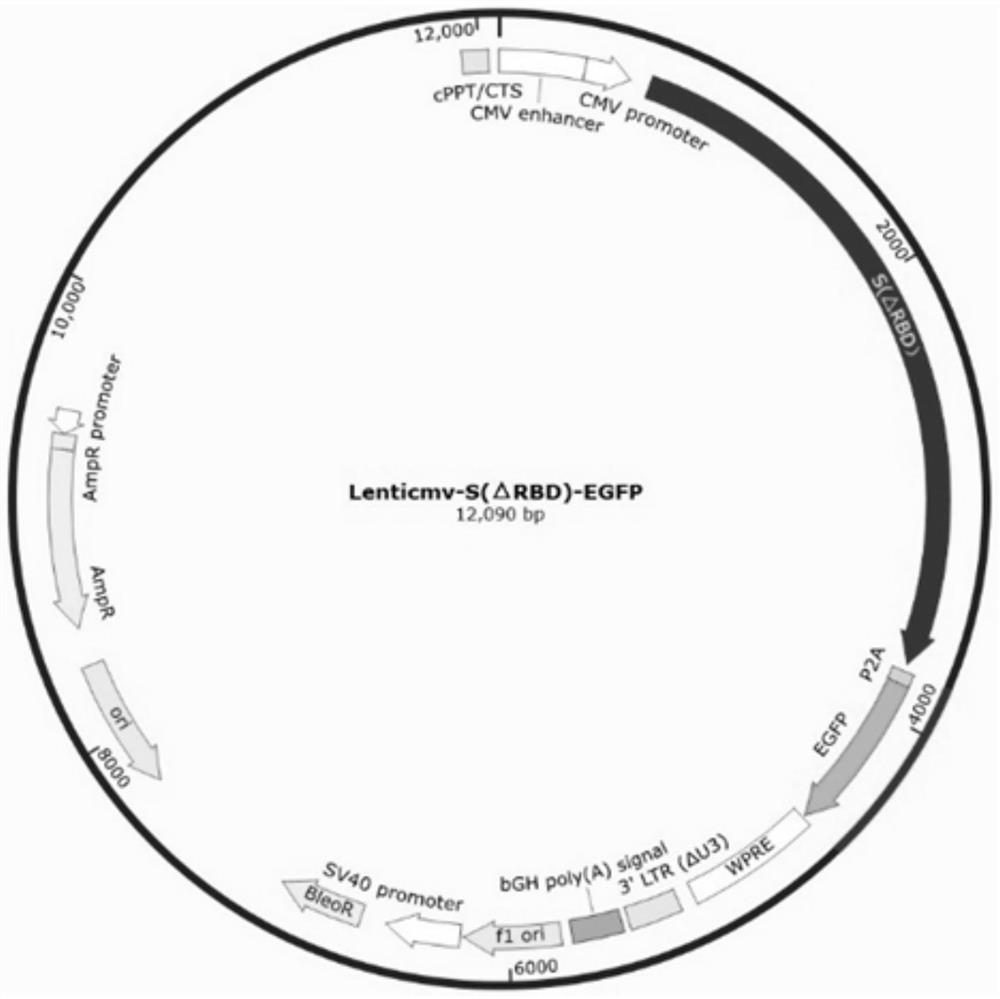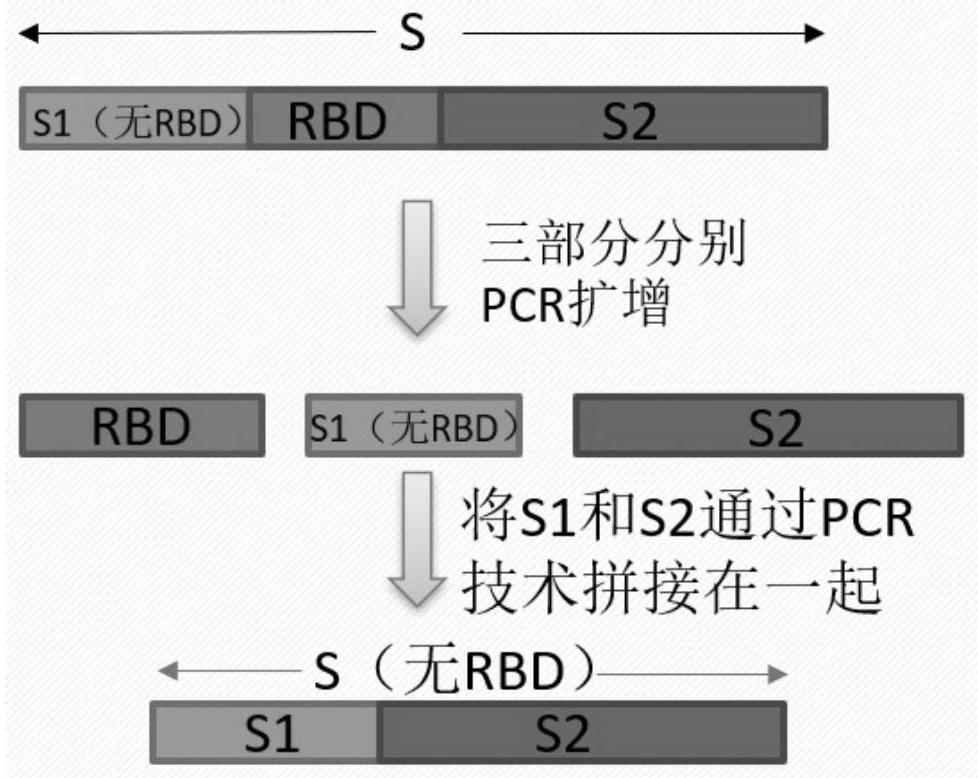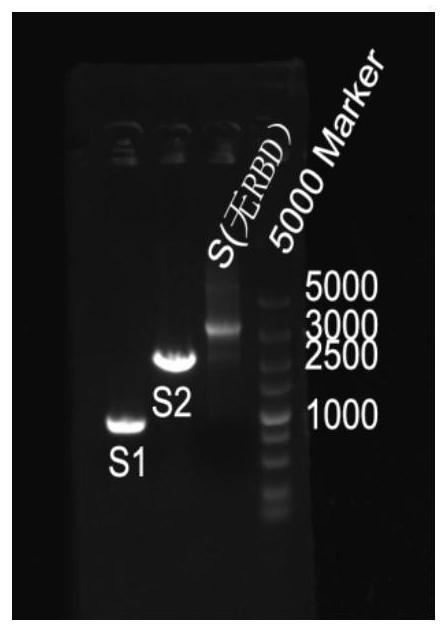Screening method and application of virus protein escape neutralizing antibody
A screening method and virus technology, applied in the fields of botanical equipment and methods, biochemical equipment and methods, applications, etc., can solve the problem of unable to suppress the rapid production of virus escape mutants
- Summary
- Abstract
- Description
- Claims
- Application Information
AI Technical Summary
Problems solved by technology
Method used
Image
Examples
Embodiment 1
[0042] Example 1 Construction of S protein expression vector with deletion of RBD fragment
[0043] Here, we used the existing SARS-CoV-2 S protein plasmid in the laboratory as a template (see the appendix for the S protein sequence and https: / / doi.org / 10.1038 / s41467-020-15562-9 for details of this plasmid). The transformation is accomplished by designing two pairs of different PCR upstream and downstream primers SNheIF and S929ecorvR, S1729ecorF and SBamHR (see the appendix for primer sequences), first using PCR technology (the product used in this laboratory is Novozan Phanta Max Super-Fidelity DNA Polymerase, the product used in the PCR technology in this example is this product, the specific reaction conditions and operation refer to the product manual) to respectively amplify the S protein parts at both ends of the RBD fragment. The primers used are SNheIF and S929ecorvR, and the primers used for the amplification of the right region of the RBD are S1729ecorF and SBamHR. ...
Embodiment 2
[0045] Example 2 Introduction of RBD fragment into S protein vector without RBD fragment
[0046] Using Error-PCR technology, using Quick-Mutation gene random mutation kit (Biyuntian D0219S), a set of primers S966ecorvF and S1713ecorR (see the appendix for primer sequences) were randomly mutated in the RBD region using RCR technology (for details, please refer to the above gene randomization Mutation reagent product instructions), and then the randomly mutated RBD fragment was digested by EcoRV and EcoRI restriction enzymes, and EcoRV and EcoRI were also used for the lenticmv-S(△RBD)-EGFP vector plasmid in Example 1. The RBD fragment was ligated with the lenticmv-S(△RBD)-EGFP plasmid using DNA ligase after restriction endonuclease digestion, and the ligated product was transformed and plated on an LB plate containing ampicillin resistance overnight. Growth, the next day colony PCR (Novizan 2×Taq Master Mix (Dye Plus), refer to the instruction manual for specific operations, se...
Embodiment 3
[0047] Example 3 Construction of S protein lentiviral plasmid library containing RBD mutation region
[0048] In order to expand the capacity of our S protein lentiviral plasmid library, we amplified the RBD fragment according to the operation in Example 2, and then compared the amplified RBD fragment and the lenticmv-S(ΔRBD)- The EGFP vector plasmid was digested with EcoRV and EcoRI restriction enzymes, respectively, and then the RBD fragment was ligated with the constructed lenticmv-S(ΔRBD)-EGFP vector (constructed in Example 1) with DNA ligase, and then the The enzyme-linked product was added to DH5α competent cells, placed on ice for 30 minutes, and then heat-shocked at 42°C for 30s. After heat shock, the competent cells were placed on ice to cool for 1-2 minutes, then 500ul LB medium was added, and the cells were incubated at 37°C on a shaker for 1-2 minutes. Shake at 200r for 30 minutes, and spread the competent enzyme-linked products on LB plates containing ampicillin. ...
PUM
 Login to View More
Login to View More Abstract
Description
Claims
Application Information
 Login to View More
Login to View More - Generate Ideas
- Intellectual Property
- Life Sciences
- Materials
- Tech Scout
- Unparalleled Data Quality
- Higher Quality Content
- 60% Fewer Hallucinations
Browse by: Latest US Patents, China's latest patents, Technical Efficacy Thesaurus, Application Domain, Technology Topic, Popular Technical Reports.
© 2025 PatSnap. All rights reserved.Legal|Privacy policy|Modern Slavery Act Transparency Statement|Sitemap|About US| Contact US: help@patsnap.com



